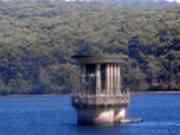The Silvan Reservoir Park below the dam wall is significant to the wider Victorian community as a traditional and extremely
popular place for family and group gatherings, including picnics and weddings, and is highly valued for its aesthetic and
recreational features. The park's attractions include the now unused Stilling Basin which forms an outstanding architectural
feature at the base of the dam wall, extensive conifer plantings, a viewing area across the reservoir, catchment and adjoining
State Forest, extensive landscaping, two stone plaque structures and the stone entrance pillars and gates.
It is located at the bottom of the downstream face of the reservoir wall, and extends up the slope beyond a carpark
and access road. The park is generally laid out with exotic tress, predominantly conifers, with the indigenous forest bordering
the park at the bottom of the wall. The slope has been landscaped into three main levels.
The
entry gates are wrought iron set into mortared mudstone pillars, and similar rock is used throughout the park for stairways,
guttering and the plaque structures. The plaque structures include one at the top of the main stairway, with two brass plaques
commemorating 'Silvan Dam No 1' and its specifications, the other listing the Board members at the time of opening in 1931.
Another structure, lower down the slope, with two plaques commemorating the opening of the Upper Yarra-Silvan pipeline on
22 October 1953.
FAUNA AND FLORA
Urbanisation, widespread clearance
of native vegetation and the construction of the reservoir has had a dramatic effect on the abundance and diversity of native
fauna in the park. Other impacts on native fauna in this area includes competition and predation from introduced animals such
as the fox, rabbit and cat. These introduced vermin have also caused widespread destruction of habitat as a result of their
behaviour.
The Park is home to a number of native mammals such as the short-beaked echidna, common brushtail and ringtail possums,
sugar glider and the common wombat. These are found in the forested areas of the Stonyford Creek. A variety of bat species
also inhabit areas of the Park, and is frequented by a diverse range of birds. Herons, spoonbills, duck species,
rosellas, wedge-tailed eagles, thornbills, treecreepers, robins, owls and cockatoo species can all be observed.
The Stonyford Creek area consists of remnant native vegetation, ranging from typical riparian to a drier open forest vegetation
type. Dominant species within this area include peppermint and messmate eucalypts, grey gums, wattles, banksias and native
grasses. A variety of fern species are also common along the creek
DEVELOPMENT
Little documented information has been located relating specifically
to the development of the park, except for a reference to improvements to the Public Reserve including trees, lawns, etc in
1938. The landscaping, confer plantings, construction of the gates and opening plaque structure appear to have been undertaken
at the same time, and more stonework has been added in recent times. The MMBW Annual Report for 1931-32 records the planting
out of 2250 Pinus insignus, 50 blackwoods, 300 silver wattles, and 60 willows, but these appear to have been planted in the
catchment to revegetate areas cleared for the construction (such as the quarry site).

